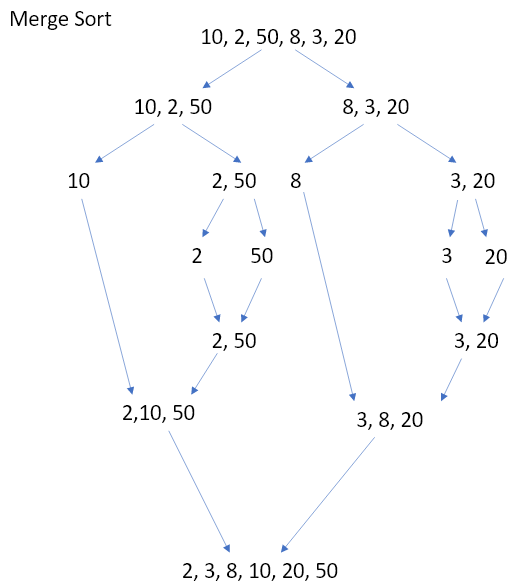合併演算法input array不斷分成兩半,直到不能再分(剩一個element),再兩兩合併各組資料,合併時排序,再合併直到排好整個資料為止。平均時間複雜度為O(nlogn),但跟bucket sort一樣空間複雜度較高O(n)。見以下圖說明。
圖1 合併排序法示意圖。
def mergeSort(mylist):
if len(mylist) < 2:
return mylist
else:
mid = len(mylist)//2
leftlist = mylist[:mid]
rightlist = mylist[mid:]
return merge(mergeSort(leftlist), mergeSort(rightlist))
def merge(left, right):
result = []
while len(left) and len(right):
if left[0] < right[0]:
result.append(left.pop(0))
else:
result.append(right.pop(0))
if len(left):
result += left
else:
result += right
return result
mylist = [10, 9, 20, 2, 16, 8]
print(mergeSort(mylist))
>> [2, 8, 9, 10, 16, 20]
首先,命第一個值作為基準值(pivot),同時將swap指標指向它,然後往下看,當遇到值小於基準值pivot時,swap指標+1,將那個值與swap指標指向的值交換,然後繼續看array的下個值,直至把整個array看完。然後將pivot跟swap指標指向的直互換。這時我們可以觀察到pivot左邊的值皆小於pivot,其右邊的值皆大於pivot。於是我們用同樣的方式處理pivot左邊於右邊的array,直至不能再分。其實時間複雜度為O(nlogn),空間複雜度為O(n)。
圖2 快速排序法式意圖。
def swap(mylist, index1, index2):
mylist[index1], mylist[index2] = mylist[index2], mylist[index1]
def pivot(mylist, pivot_index, end_index):
swap_index = pivot_index
for i in range(pivot_index+1, end_index+1):
if mylist[i] < mylist[pivot_index]:
swap_index += 1
swap(mylist, swap_index, i)
swap(mylist, pivot_index, swap_index)
return swap_index
def QuickSort(mylist, left, right):
if left < right:
pivot_index = pivot(mylist, left, right)
QuickSort(mylist, left, pivot_index-1)
QuickSort(mylist, pivot_index+1, right)
return mylist
def Quick(mylist):
left = 0
right = len(mylist)-1
return QuickSort(mylist, left, right)
my_list = [3, 5, 0, 6, 2, 1, 4]
print(Quick(my_list))
>> [0, 1, 2, 3, 4, 5, 6]
大家還記的我們之前講的min-heap還有max-heap嗎?Heap Sort借用了一些Binary Heap的概念。但如果真的照之前做的insertnode會發現,只有root和children間有排序,同一個parent不同children間並沒有排到,所以改成下面的作法,我覺得蠻神奇的蠻難自己想到的~
時間複雜度:O(nlogn), 空間複雜度:O(1)
def heapify(customList, n, i):
# the index of the smallest number
smallest = i
# left child and right child
l = 2*i+1
r = 2*i+2
if l < n and customList[l] < customList[smallest]:
smallest = l
if r < n and customList[r] < customList[smallest]:
smallest = r
if smallest != i:
customList[i], customList[smallest] = customList[smallest], customList[i]
heapify(customList, n, smallest)
def heapSort(customList):
n = len(customList)
# 將每一個有children的node和他們的children做筆記和排序
for i in range(n//2-1, -1, -1):
heapify(customList, n, i)
#這步我覺得挺神奇的,如果實際畫畫看,真的就把剩下沒排完的全部排好
for i in range(n-1, 0, -1):
customList[i], customList[0] = customList[0], customList[i]
heapify(customList, i, 0)
customList.reverse()
cList = [2, 1, 9, 8]
heapSort(cList)
print(cList)
>> [1, 2, 8, 9]
但其實python就有module在做這件事,大家可以看看heapq的文件,看看怎麼操作,以下為文件內的範例:
import heapq
def heapsort(cList):
h = []
for value in cList:
heapq.heappush(h, value)
return [heapq.heappop(h) for i in range(len(h))]
cList = [2, 1, 9, 8]
print(heapsort(cList))
>> [1,2,8,9]
那下面總結一下,不同sorting方法的時間、空間複雜度:
好囉~那明天我們繼續來看搜尋演算法~
參考資料:
本文主要為udemy課程: The Complete Data Structures and Algorithms Course in Python的學習筆記,有興趣的人可以自己上去看看。
